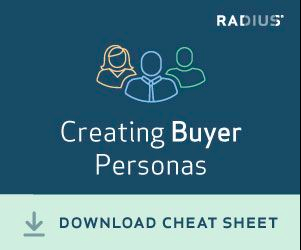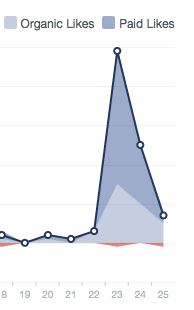In the B2B marketing organization, content marketing often gets lumped into the general bucket of inbound marketing.
But as organic reach becomes increasingly difficult to achieve amidst the noise, more marketers use content to fuel paid online advertising campaigns. At Radius, we’ve run experiments surrounding content marketing and digital advertising, and have pulled together the results below.
A couple of months ago, we made dramatic messaging changes to reflect game-changing new product capabilities. However, with new messaging comes new target keywords. We did some analysis on our site and came to the conclusion that our SEO lag for new keywords would be anywhere between 6 months to 1 year. This meant that to acquire organic traffic from our target audience with our new keywords, we’d have to wait at least 6 months.
“Content marketing is even more important to our lead generation efforts than we anticipated.”
In this crazy and constantly evolving world of B2B marketing, we didn’t have 6 months. Before we announced a new funding round and launched into event season, we had to dramatically increase our brand awareness around these keywords and ramp up our sales pipeline.
To gain traction with a new audience, we created a collection of B2B Marketing Cheat Sheets that we gated behind landing pages, and used paid advertising to drive leads to them. We introduced A/B testing into our campaign process to establish the best recipe of topics and channels, and discovered that content marketing is even more important to our lead generation efforts than we anticipated.
Crafting the Right Call to Action
To measure comparative results for our cheat sheets, we ran them alongside a couple of other ads in 2-week sprint intervals. So for two weeks, we pushed a number of different advertisements across a bunch of ad channels, then turned off the ads, measured the results, and turned on a brand new set of ads.
We designed three different types of ads:
- Ads that directed prospects to fill out a form and download a cheat sheet
- Ads that invited prospects to sign up for a demo of Radius and resulted in personal sales calls from our team
- Ads that invited prospects to learn more and directed them to a demo sign up page on our website

During each sprint, we ran ads that contained a single call to action. We tested the same 3 calls to action for roughly 3 months worth of advertising sprints:
- Download Cheat Sheet
- Learn More
- Sign Up for Demo

We anticipated that the cheat sheets would perform better than the demo and learn more ads, but we were blown away to discover how far ahead of the other 2 calls to action the cheat sheets performed:
- Download Cheat Sheet generated 93% of total leads from campaign
- Learn More generated 5% of total leads from campaign
- Sign Up for Demo generated 2% of total leads from campaign
Clearly our target audience (B2B marketers) prefers content to sales demos.
Even though we had to pay to put our content in front of our prospects, the results were instantaneous. In just a couple months, we generated thousands of leads for B2B marketing topics around which we had very little organic authority.
Allocating Budget Across Channels
Testing our messages was only the first A/B test of our cheat sheet experiment. Next, we needed to determine which advertising channels were the most fruitful.
To do so, we basically blasted a finely honed audience on every channel imaginable.
Take a look at how a single cheat sheet, Keeping Your CRM Clean, performed across a selection of channels:
- 59% of leads came from LinkedIn sponsored posts
- 23% of leads came from Adwords display ads for remarketing and keyword search
- 8% of leads came from Bizo for look-alike audience targeting
- 5% of leads came from Facebook News Feed ads
- 5% of leads came from Twitter ads
- 0% of leads came from LinkedIn display ads
This particular cheat sheet collected a slightly higher than average lead volume in comparison to other cheat sheets. In an interesting turn of events, the LinkedIn display ads, which come with a higher price tag than most other online ad networks, generated a whopping total of zero leads. To be fair, we ran this cheat sheet before LinkedIn bought Bizo for the purpose of improving their ad products.
Again, our findings prove that our prospects (B2B marketers) prefer the ad channel that makes only a very small distinction between sponsored ads and user contributed articles (a small, gray patch of text reads “sponsored” in the top right corner of all LinkedIn sponsored posts).
Finding an Unexpected Lift in Organic Reach
Benjamin Ray, Co-founder and Chief Scientist at data-powered social media marketing firm Wisemetrics, cracked the myth that promoted posts have any impact on your organic reach on Facebook, and similar wisdom abounds about the impact paid promotion imparts on Google, Twitter, and LinkedIn.
“Facebook is fair and does dissociate promoted posts from organic reach.” –Benjamin Ray
However, through our cheat sheet experiment, we discovered an indirect benefit that our investment in paid promotion delivers to our organic reach on social.
As we invest increased sums of cash into our Facebook, LinkedIn, and Twitter ads, our community of fans and followers grows at a much quicker rate than it did prior to the launch of our advertising campaigns.
Look what happens to our volume of new likes on the day we announce new funding. A “paid like” on Facebook is a like that came from paid content.
The same thing happens on LinkedIn:

Our organic reach increases when we pay for social ads because the audience to whom our content is exposed grows.
Summarizing the Takeaways
Demandmetric reports that 78% of CMOs think custom content is the future of marketing. The results of our summer of cheat sheets supports this claim.
At the top of the funnel, business-to-business audiences prefer content marketing to sales pitches—by a landslide. Whether you’re paying to put content in front of your audience or waiting for inbound leads, it’s clear that an investment in your content marketing programs is a worthwhile expenditure.
